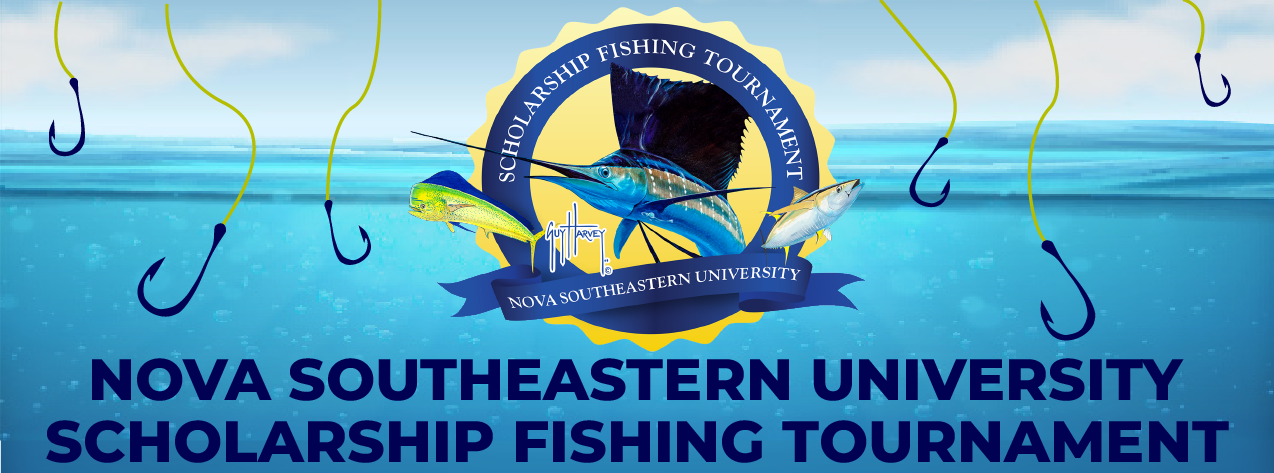
Meet Our NSU FT Scholarship Awardees in 2022-2023
Travis Kirk
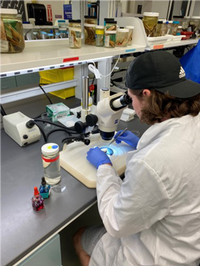
Travis Kirk The deep-pelagic ocean is considered to be the largest ecosystem on earth, yet remains the least researched. As a result, there is much to learn about the organisms that call this area home. My research project investigated the trophic ecology of the predatory fish genus Chiasmodon, commonly known as the Black Swallowers. This is a very understudied genus of predatory fishes, with very limited literature on their biology and ecology published in the scientific realm. Through highly intensive stomach content analysis, I dissected over 300 individual Chiasmodon specimens and removed their prey contents from their stomach. From this point, I identified which major taxon their prey items belonged to, and took note of other statistical parameters to be used for further analysis. This then allowed for further research questions to be answered, such as feeding selectivity and daily ration. Overall, these questions aimed to provide an idea of Chiasmodon’s predation impact in the deep-pelagic environment, and collected baseline data for a previously unknown taxon of fishes. The results from this study can be used as a reference for future trophic studies of other deep-pelagic fishes. The funding provided to me from the NSU Batchelor Fishing Tournament Scholarship was instrumental in providing me with the tools needed to complete this project. The knowledge and skills I developed throughout this project have been invaluable, and I now plan to use this knowledge to progress my career as a fisheries biologist.
Zachary Graff
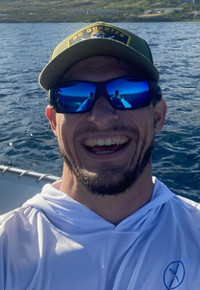
Zachary Graff-Population Dynamics of Florida’s Vital Parrotfish Coral reefs are undergoing rapid decline with an estimated 30% severely damaged and a predicted 60% reduction in total coral cover by 2030 in the greater Caribbean. Contributing factors include warming seas, pollution, coastal development, rampant coral disease, and overfishing of many vital reef fish species. These environmental stressors have consequently caused many coral reefs in southern Florida to shift towards macroalgae dominated ecosystems. This macroalgae abundance has a profound negative impact on the growth of new corals and the survival of existing coral colonies. When these massive coral colonies die the valuable habitat-providing structures that they provide quickly erode lowering reef complexity which has a cascading effect on the local ecosystem. Parrotfish are a vital part of Southern Florida’s coral reef ecosystem function, studies have shown that intense herbivory may be the only natural means of controlling recent macroalgae abundance on Caribbean coral reefs and with the die-off of Diadema urchins in the early 1980s parrotfishes are now the dominant grazers on Florida’s coral reefs capable of removing large amounts of macroalgae from a reef ecosystem. However, population dynamics of this important group of reef fish have historically been understudied in Florida. Parrotfish feeding and ingestion rates are shown to increase exponentially with size and research in the greater Caribbean has shown that the removal of these important large parrotfishes from an ecosystem via overfishing can increase microalgae biomass on a coral reef 4 to 10 fold so researchers are specifically interested in the abundance of larger size classes of parrotfishes in Florida. Using National Coral Reef Monitoring Program fish survey data from 2012-2022 my colleagues and I have discovered that despite over 30 years of state level protection Florida’s parrotfish population is overwhelmingly composed of smaller fish. Our results illustrated size classes heavily skewed towards smaller individuals with 46.76% of Florida’s parrotfish below 11cm in length and 82.68% under 30cm. Densities and biomasses are higher in the Florida Keys than in any other area of the State and interestingly marine protected areas see a higher abundance of larger sized parrotfishes. This information will be useful to coral reef ecologists as they determine if current levels of protection can support a healthy population of parrotfishes capable of removing the increasing biomass of macroalgae on our coral reefs. I have performed well over 1,000 research dives as a graduate student and coral ecosystems researcher in my time at NOVA Southeastern university and this funding has allowed me to further investigate the population dynamics of this vital group of reef fish and hopefully shed some light on what must be done to protect this important component of Florida’s coral reefs.
Hannah Johnson
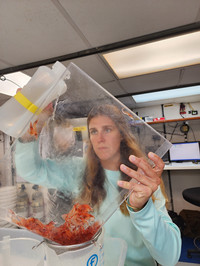
My thesis project concerns the reproductive ecology of a key predatory meso/bathypelagic fish taxon, Chiasmodon (Scombriformes: Chiasmodontidae) in the Gulf of Mexico. Nothing is known about reproduction in the predatory fish genus Chiasmodon. This project will investigate aspects of reproduction, including: separation of sexes (i.e. potential hermaphroditism), size at maturity, spawning frequency/timing, and gonad development. This information will then be applied to understand and document the life maturity stages of Chiasmodon, provide the first characterization of its reproductive cycle, and quantify the distribution of Chiasmodon at varying life stages in the Gulf of Mexico. Throughout the duration of my Master’s, I will be working as the Laboratory Manager and Research Assistant under Dr. Tracey Sutton and Dr. Rosanna Milligan.
Miranda Brohman
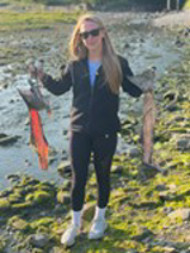
Miranda Brohman Alaska is home to a large biomass of both people and animals and one of the most remote habitats in all the United States. With any large population comes the downfalls, especially to any land or marine habitats with pollutants created both naturally and anthropogenetically. Alaska is also home to a large population of indigenous people that rely heavily on subsistence harvesting to feed and provide for their families. An estimated 36.9 million pounds of food annually is harvest for subsistence purposes with 32% coming from salmon and another 21% from other finfish species. Understanding the importance of these commercially and economically important salmon species is key to determining the state of the environment. This study utilized 16 heavy metals to examine seven different tissue types in three species of salmon: Chum salmon (Oncorhynchus keta), Coho salmon (Oncorhynchus kisutch), and Pink salmon (Oncorhynchus gorbuscha) to determine interspecific and locational differences between all. Being the first of its kind, this research will serve as a major finding and with the help of the fishing tournament scholarship I will be able to present my findings at major conferences both in Florida and Alaska. Having this opportunity will not only spread the word of what my research found but also showcase all the amazing work that NSU does every day even from the other side of the country in Alaska. Funding research here at NSU not only allows students to analyze more samples and yield more critical results but gives students the opportunities to produce more robust studies and incorporate more aspects to design one-of-a-kind studies not seen anywhere else.
Meet Our NSU FT Scholarship Awardees In 2018 and 2019
Elizabeth Murphy McDonald

Coral reefs face a number of threats that have led to their widespread decline in recent decades, including warming sea temperatures and ocean acidification. In recent years, coral disease has also emerged as one of the most pressing and unpredictable threats to coral reefs. This is particularly true in the Caribbean, which is known as a ‘disease hotspot’ for its uniquely high prevalence and frequency of disease. Today, the Florida Reef Tract is experiencing a highly lethal, multi-year, multi-species coral disease outbreak that has already spread through hundreds of kilometers of reef since its origination in 2014. This current disease outbreak is unprecedented in its scale and anticipated damage, necessitating important research to understand more about its biology and cause.
Glenn Goodwin

Three of the five species of sea turtles that inhabit South Florida waters nest on Broward County (BC) beaches: loggerhead turtles (Caretta caretta), green turtles (Chelonia mydas), and leatherback turtles (Dermochelys coriacea). Loggerhead and green turtles constitute 95% and 5% of nests, respectively; less than 1% of sea turtle nesting in BC is attributed to leatherback turtles (Burkholder and Slagle 2017). The U.S. Endangered Species Act lists both loggerhead and green turtles as threatened, and both species are listed under Appendix I by the World Conservation Union (IUCN 2018). These species are further protected under Florida state statutes through the Florida Fish and Wildlife Conservation Commission (FWC), granting international and federal protection.
Meet Our NSU FT Scholarship Awardees In 2016 and 2017
Megan Bock
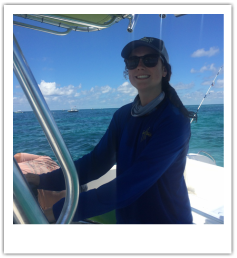
Since the 1970s, populations of the reef-building coral Acropora cervicornis have rapidly declined throughout the Caribbean. Consequently, it has been listed as critically endangered under the International Union for the Conservation of Nature Red List and threatened under the U.S. Endangered Species Act. Population losses in the Caribbean have reached up to 98% in some areas and have primarily been attributed to white-band disease (WBD) and rapid tissue loss (RTL). A positive linear relationship between disease prevalence and increased water temperature has been described, however, the pathogens of WBD and RTL, their vectors, and their transmission are poorly understood. With an estimated average sea-surface temperature rise of 1.8‒4.0 °C by the end of the 21st century, higher incidences of coral bleaching and disease outbreak are predicted.
Matthew Woodstock
The open-ocean waters of the Gulf of Mexico have a vastly different array of fishes at night than during the day. Deep-sea (> 200 m depth) fishes migrate upwards to shallower waters at night to feed on small crustaceans, and are consumed by commercially important fishes, such as tunas and billfishes. Once eaten, the parasites of the prey fish are transferred to their next host to complete their life cycle. I have found that specific parasites can be found in specific fishes. Different fishes also eat different types of crustaceans, potentially being a necessary mechanism for parasites to move from one life stage to the next.
Meet Our NSU FT Scholarship Awardee In 2013 and 2014
Matthew Johnston

The impacts of marine invasive species, though still relatively uncommon, tend to be more widespread than their freshwater counterparts due to a relatively open and connected ocean environment. As marine invasions increase in frequency, predicting colonization sequences of marine invaders has become a core focus of resource managers and the use of species distribution models (SDMs) for the study of invasive species biology is becoming more prevalent. The development of hybrid models combining mechanistic and phenomenological approaches attempt to address both the potential distribution of as well as timing of invasions, however, there remains a substantial lack of readily accessible tools to create such models. The motivation behind this study is to develop a unique hybrid SDM to understand the invasion process which can be used to help prevent marine invasions from occurring.
Meet Our NSU FT Scholarship Awardee In 2009 and 2010
Andrea Bernard

The 2006 identification and validation of the billfish species, the roundscale spearfish (Tetrapturus georgii) by NSU’s Dr. Mahmood S. Shivji, has revealed that the species traditionally categorized as “white marlin” in catch records is actually composed of two very different species. This previously unrealized mix-up has severely complicated conservation and management efforts for the threatened white marlin. It is now recognized that due to decades of species misidentification, management efforts for the overfished “white marlin” have unknowingly been applied to a species complex comprising the white marlin and roundscale spearfish. Potential impacts of this species misidentification may be severe, making it essential that both white marlin and roundscale spearfish are managed and conserved as separate species. This new management paradigm will require a thorough re-evaluation of the current information on the white marlin, and collection of data for the newly recognized roundscale spearfish starting from scratch.
